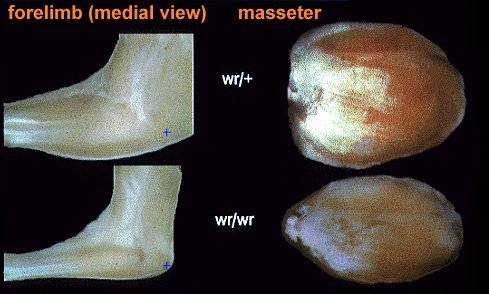 Reduction of lower motor neuron degeneration in wobbler mice by N-acetylcysteine
Reduction of lower motor neuron degeneration in wobbler mice by N-acetylcysteine| inabis '98 Home Page | Your Symposium | Related Symposia & Posters | Scientific Program | Exhibitors' Foyer | Personal Itinerary | New Search |
 Reduction of lower motor neuron degeneration in wobbler mice by N-acetylcysteine
Reduction of lower motor neuron degeneration in wobbler mice by N-acetylcysteineJeffrey T. Henderson, Mohammed Javaheri, Susan Kopko and John C. Roder
Samuel Lunenfeld Research Institute, Mount Sinai
Hospital,
Program in Molecular Biology and Cancer, 600
University Ave., Toronto, Ontario M5G-1X5
Introduction
A variety of stimuli have been shown to elevate intracellular levels of reactive oxygen species (ROS), which in turn enhance the rate of programmed cell death in different neural cell types (Sheen and Macklis, 1994; Kroemer et al., 1995; Greenlund et al., 1995; Verity et al., 1995). These stimuli include, growth factor withdrawal (Mayer and Noble, 1994; Ferrari et al., 1995; Greenlund et al., 1995), ischemia (Folergrova et al., 1995; Knuckey et al., 1995) and glutamate-mediated excitotoxicity (Dugan et al., 1995; Mattson and Goodman, 1995; Schulz et al., 1995). The importance of ROS in programmed cell death has also been suggested from the neuroprotective effects of bcl-2 family proteins, which appear to act by inhibiting ROS-induced cell damage ( Kane et al., 1993; Zhong et al., 1993; Myers et al., 1995; Lawrence et al., 1996). In humans, elevated ROS levels have also been linked to neuropathies such as Parkinson's disease, Huntington's chorea, Alzheimer's disease, infantile spinal muscular atrophy and amyotrophic lateral sclerosis (ALS) (Olanow and Arendash, 1994; Beal, 1995; Eisen, 1995; Mattson and Goodman, 1995).
The compound N-acetylcysteine (NAC) has been shown to inhibit ROS, thus increasing the viability of cells in culture, including: spinal motor neurons (Rothstein et al., 1994); oligodendrocytes (Mayer and Noble, 1994); cortical neurons (Rattan et al., 1994); superior cervical ganglion neurons (Yan et al., 1995); and PC-12 cells (Ferrari et al., 1995; Yan et al., 1995). In vivo, NAC has also been shown to reduce the toxicity of compounds such as methyl mercury, which produce oxidative stress (Ornaghi et al., 1993). In humans, extensive clinical experience with NAC suggests it is a compound of low toxicity, most commonly used to counteract the oxidative damage caused be acetaminophen overdose, as a mucolytic, or in the treatment of AIDS (Berkow and Fletcher, 1992; Brennan and O'Neil, 1995). NAC appears to exert these effects either by acting directly as an antioxidant, as a precursor of glutathione synthesis, or through gene induction ( Brennan and O'Neil, 1995; Staal et al., 1995).
Because of the link between oxidative damage and neural degeneration in vitro, we examined the possibility that agents which inhibit the formation of ROS may be useful as therapeutic agents in vivo for certain forms of neural degeneration. We used the murine mutant wobbler (wr), a recessive mutation which induces lower motor neuron degeneration, primarily within the cervical spinal cord and the cranial motor nuclei (Duchen and Strich, 1968; Andrews, 1971; Bird et al.,1971). Homozygous wr/wr animals are distinguishable by 3-4 weeks of age by their unsteady gait and fine head tremor. Homozygous wr animals also exhibit skeletal muscle atrophy, infertility and increased mortality (Bird et al., 1971; Baulac et al., 1983).
Histological analysis of the cervical spinal cord of wobbler mice demonstrates, Wallerian degeneration, reductions in axon caliber, and decreases in choline acetyl transferase (ChAT) activity in the anterior horn by 8 weeks of age (Bird et al., 1971; Mistumoto and Bradley, 1982; Baulac et al., 1983). Affected neurons may exhibit signs of sprouting, and eventually undergo vacuolar dilation of the golgi complex and endoplasmic reticulum (Mistumoto and Bradley, 1982; Vacca-Galloway and Steinberger, 1986). The morphological properties of degenerating wobbler neurons, together with the lack of inflammation at these sites, suggests that wobbler motor neurons do not die by necrosis (Andrews, 1975; Mistumoto and Bradley, 1982; Ma et al., 1991).
To examine the effects of NAC on motor neuron degeneration in vivo, we treated wobbler mice orally with NAC over a period of nine weeks. The results demonstrate that NAC treatment reduces the decline in several important morphological and functional parameters of neurodegeneration.
 Anatomic effects of the wobbler mutation (66 days postnatal)
Anatomic effects of the wobbler mutation (66 days postnatal)
Introduction